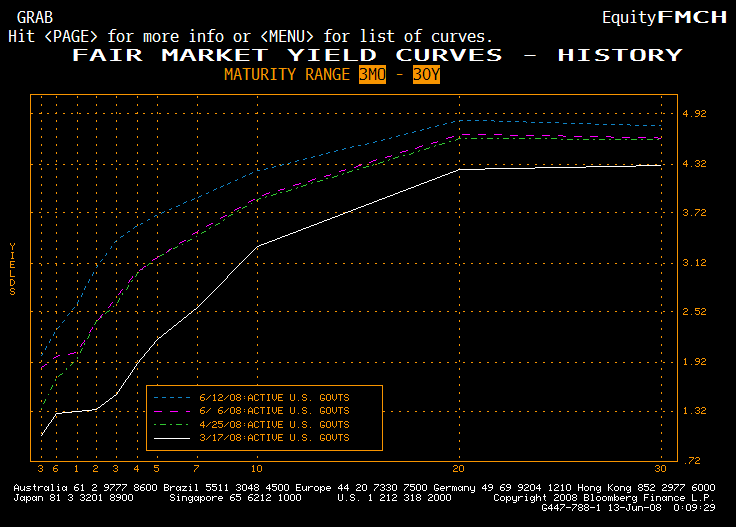My, but haven’t we had interesting times in the short end of the yield curve lately. Have a look at this graph:

This covers the period from the final aggressive 75 basis point move by the FOMC, where there were expectations of a 1% fed funds rate by year end 2008, to now, where the rate at year end is between 2.5-3.0%.? Now look at this chart, which summarizes the yield curve moves:

The graphs and numbers tell a story.? My four datapoints represent:
- 3/17 – The sharpest point in the loosening cycle, prior to going to 2.25%.
- 4/25 – Anticipation of the end of the loosening cycle.
- 6/6 – FOMC jawboning that we must support the dollar and fight inflation.
- 6/12 – Now.
Let’s describe the moves, period by period.? In Period 1, the transition was from maximum FOMC accomodation to the end of the loosening cycle.? What happened?? Investors required more yield to invest for two years versus cash instruments, because they concluded that short rates would not go near record low levels.? The long end of the curve flattened, because inflation expectations were under control.
In period 2, things were quiet.? Three month rates rose to reflect the new consensus that the FOMC was on hold after the 4/30 meeting for the foreseeable future.? The rest of the curve did nothing.
In period 3, members of the FOMC began beating the inflation drum, particularly the hawks, including Plosser, Lacker, Fisher, and Bernanke.? The belly of the curve (twos to fives) rises the most, anticipating tightening moves by the FOMC, leading the long end to flatten, and the short end to steepen.? This implies that inflation will remain under control in the long run, an idea borne out by the TIPS market, where you can buy 20+ year inflation protection at a real yield of 2.3% — a pretty good bargain for investors that must own Treasuries and other high quality debt.
I’ll give the FOMC this.? In the last four trading days, they helped create the biggest move in the 2-year note yield that we have seen in a long time.? They managed to push up 30-year mortgage yields around 35 basis points, close to the move in the 10-year note.
Now, (to the FOMC) is that what you wanted?? Go ahead.? Start tightening monetary policy in August or September.? See what that does to the investment and commercial banks.? See how that affects weakening employment.? Do it during an election year, when politicians in 2009 might say, “Central bank independence hasn’t helped the nation.? Let’s clip the wings of the Fed.”
I see the FOMC tightening, and then abandoning the tightening early, and reverting to a weak policy, accepting more inflation for the sake of growth in the real economy, and leniency to banks that are facing tough market conditions.

Hi, David. Found you via big picture. I couldn’t agree with you more on this point. I’ve been blogging about the Fed being in Checkmate for a while now: http://tinyurl.com/4noxt4
The Fed can either fight inflation or fight the housing crisis – but not both. As such, they can posture all they want, but I don’t see how they can stick to a tightening policy that will lead to more housing pain. This is especially true in an election year.
They will have to pick their poison and it will be inflation.
If they do otherwise, I’ll tip my hat to them.
Regards,
George The Greek From Canada!